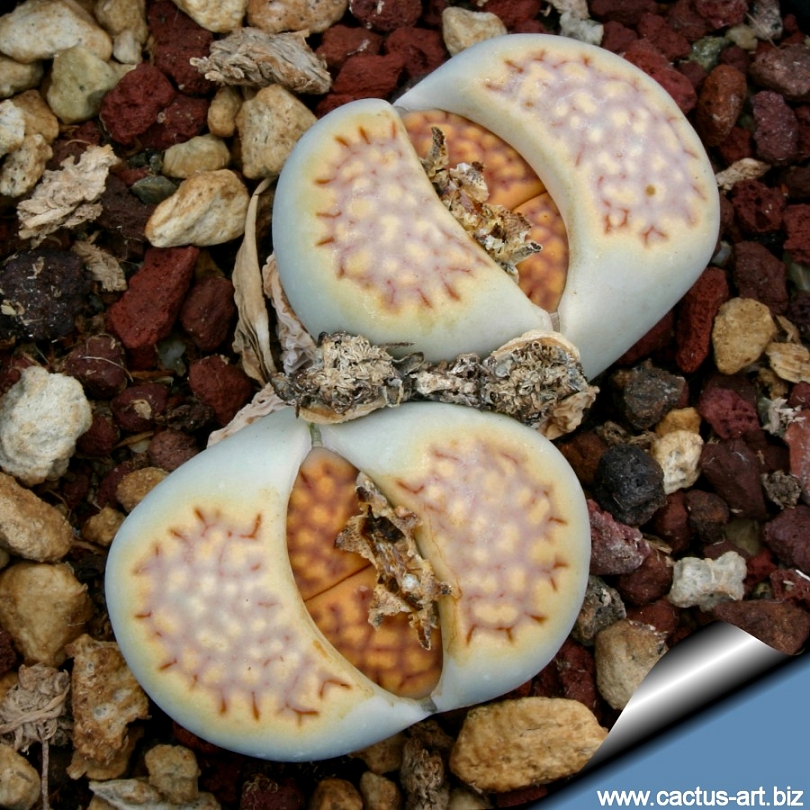 |
| Photo from Lithops.info Lithops hallii v. hallii 30 km SE of Hopetown, South Africa |
L. hallii is one of the most variable white flowering species related and often synonymized to Lithops julii (including Lithops fulleri). This is a nice plant with a delicate pastel-chartreuse colours. Furthermore it shares several characteristics with Lithops hookeri and Lithops salicola. This plant clumps up quickly and forms small clumps with up to 6 or more heads. It is relatively easy to manage like that where many other species would quickly kill themselves. Some people consider it one of the most tolerant of overwatering.
Desmond Cole field number C087: This population distinguishes for having reddish-brown leaves with broad interlacing network of windows with mostly small islands and fairly distinct irregularly dentate margins.
Family: Aizoaceae (ay-zoh-AY-see-ee)
Genus: Lithops (LY-thops)
Species: hallii (HALL-ee-eye)
Cultivar: Salicola Reticulata
Origin and Habitat: South africa, Cape Province.
TL: 30 km South-East of Hopetown, South Africa., 30 miles South of Prieska.
TL: 30 km South-East of Hopetown, South Africa., 30 miles South of Prieska.
Habitat: Grows on a white and arid flat limestone formation. Grows mainly on flat limestone terrains, with calcrete stones and fine-grained dark sandstone.
Synonyms:
Lithops hallii C087 (syn. salicola reticulata) TL: 30 km SE of Hopetown, South Africa
Lithops salicola var. reticulata C087 (syn. Lithops hallii ) TL: 30 km SE of Hopetown, South Africa
Lithops hallii var. salicola
Lithops hallii var. hallii
Lithops salicola var. reticulata
Category:
Cactus and Succulents
Foliage Color:
Colours of the backgrounds yellow-brown, grey-brown, grey-white, grey, brown, with some red, black; yellow or grey-brown.
Bloom Characteristics:
The blooms are white 20-45 mm in diameter.
Water Requirements:
Drought-tolerant; suitable for xeriscaping
Average Water Needs:
Water regularly; do not overwater
Where to Grow:
Suitable for growing in containers
This plant is suitable for growing indoors
Height:
under 6 in. (15 cm)
Spacing:
3-6 in. (7-15 cm)
Hardiness:
USDA Zone 10a: to -1.1 °C (30 °F)
USDA Zone 10b: to 1.7 °C (35 °F)
USDA Zone 11: above 4.5 °C (40 °F)
Sun Exposure:
Sun to Partial Shade
Light Shade
Partial to Full Shade
Danger:
N/A
Bloom Color:
White
Bloom Time:
Mid Fall
Late Fall/Early Winter
Foliage:
Grown for foliage
Smooth-Textured
Succulent
Soil pH requirements:
6.6 to 7.5 (neutral)
7.6 to 7.8 (mildly alkaline)
7.9 to 8.5 (alkaline)
8.6 to 9.0 (strongly alkaline)
Patent Information:
Yet to be known
Propagation Methods:
From seed; winter sow in vented containers, coldframe or unheated greenhouse
From seed; sow indoors before last frost
From seed; direct sow after last frost
Need an open mineral, fast draining mix and the maximum amount of light you are able to give them. The basic cultivation routine is: Stop watering after flowering. Start watering after the old leaves completely dry. (Usually late March or Early April) Water freely during the growing season, soak the compost fully but allow it to dry out between waterings, no water when cold. Some growers fertilize frequently, some hardly ever. Keep them dry during the winter. Nearly all problems occur as a result of overwatering and poor ventilation especially when weather conditions are dull and cool or very humid. This plant is best for a well lit area (Bright shade to full sun). But don't be afraid even the best growers have plants that mysteriously dry up, or leave during the night.
Need an open mineral, fast draining mix and the maximum amount of light you are able to give them. The basic cultivation routine is: Stop watering after flowering. Start watering after the old leaves completely dry. (Usually late March or Early April) Water freely during the growing season, soak the compost fully but allow it to dry out between waterings, no water when cold. Some growers fertilize frequently, some hardly ever. Keep them dry during the winter. Nearly all problems occur as a result of overwatering and poor ventilation especially when weather conditions are dull and cool or very humid. This plant is best for a well lit area (Bright shade to full sun). But don't be afraid even the best growers have plants that mysteriously dry up, or leave during the night.
Seed Collecting:
Allow pods to dry on plant; break open to collect seeds
Allow seedheads to dry on plants; remove and collect seeds
Properly cleaned, seed can be successfully stored
Other details:
After flowering in the autumn, and extending through winter season the plant doesn’t need watering, but they will still be growing, the new bodies will be increasing in size extracting water from the outer succulent leaves, allowing them to shrivel away. The plant in this time extracts water and nutrient stored in the outer succulent leaves, allowing them to dehydrate relocating the water to the rest of the plant and to the new leaves that form during this period until the old leaves are reduced to nothing more than "thin papery shells".
 |
| Lithops hallii Gelkop from cactus-art.biz |
 |
| Lithops Hallii Gelkop from cactus-art.biz |
 |
| Lithops halli C087 Syn: L. salicola "reticulate" |


No comments:
Post a Comment